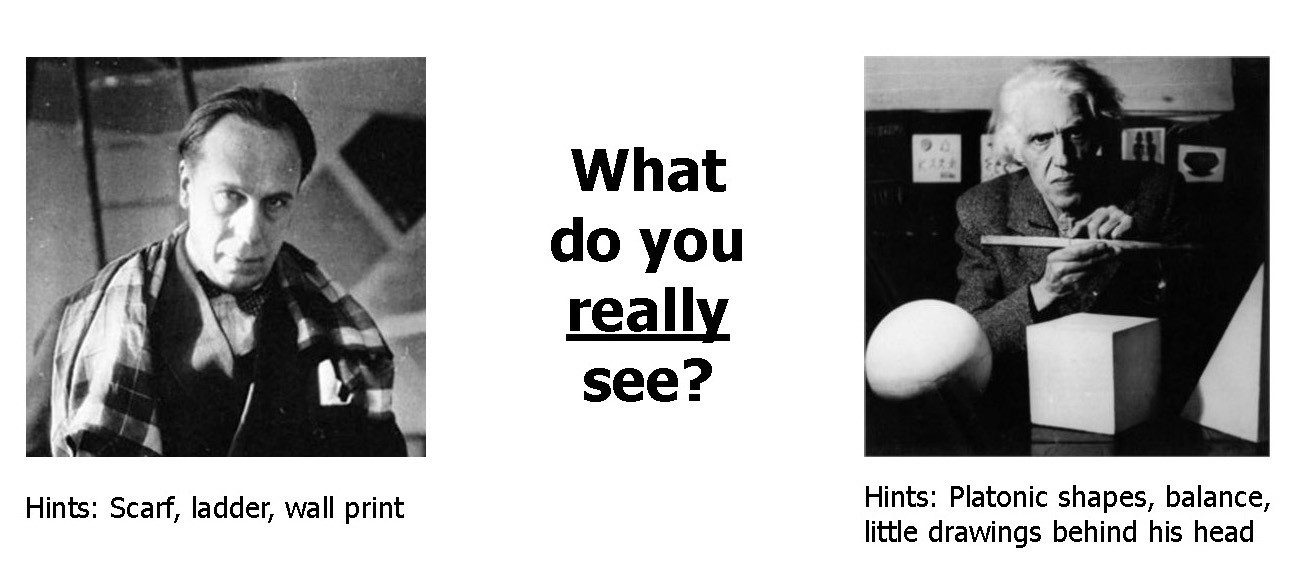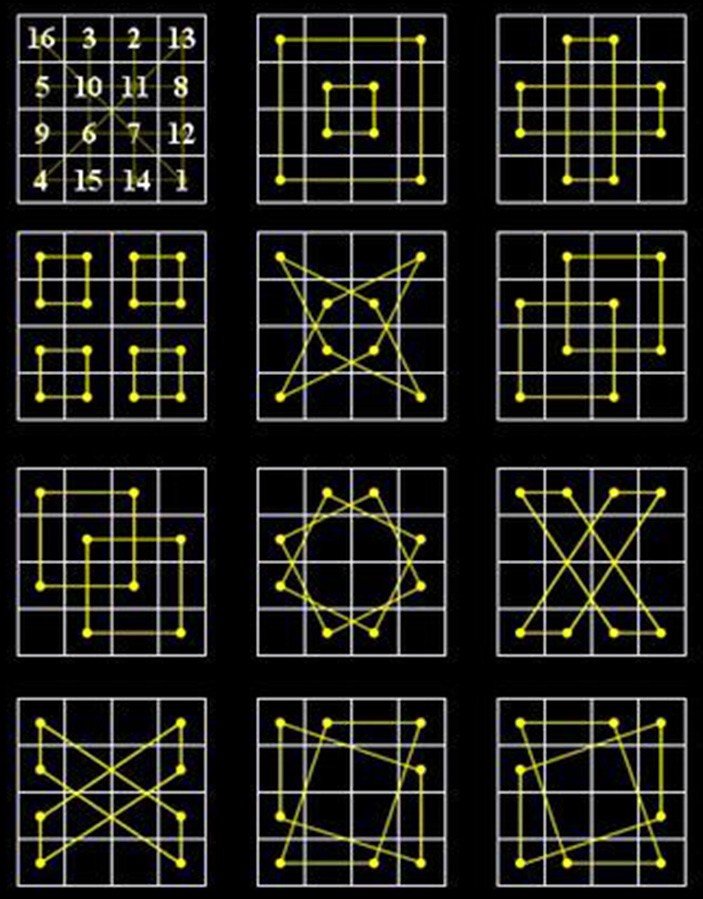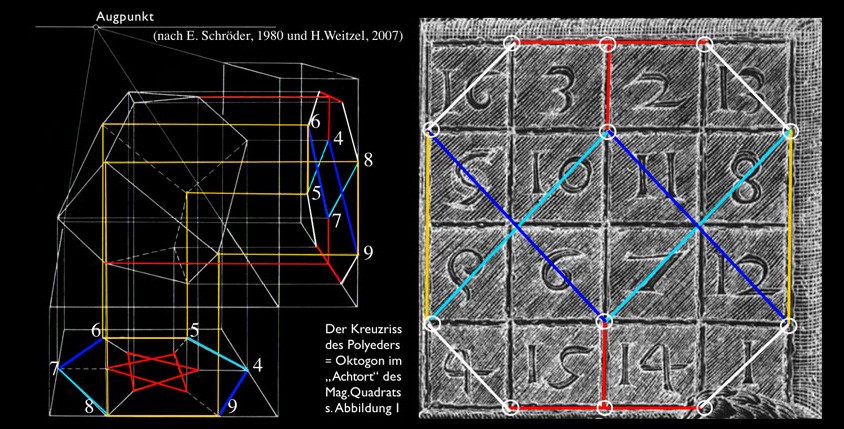M1 [§] : Dürer’s monistic masterpiece
“All things which are similar and therefore connected, are drawn to each other’s power.” — Heinrich Cornelius Agrippa
The German artist Albrecht Dürer, son of a Hungarian Goldsmith named Türer (Ajtó, Gates), is the creator of a heavily discussed copperplate engraving M1; Melencolia I.
Dürer (1471–1528) is a prime example of the renaissance polymath. A painter, printmaker, theorist, and besides that Dürer endeavoured in the fields of geometry (mathematics) and had a keen interest in astrology and alchemy. He was both a student and a teacher.
During his trips to Italy, Dürer got influenced by the work of Mantegna, Leonardo, and Bellini. In turn he influenced many Italian artists through his printed works.

Applied Dimensional Design
Previously I wrote about the painted artist’s rooms of Hans Holbein the Younger (Mirage Buildings; obsession reflection), Hansegger (Hansegger : A Question of Style) and Marcels Duchamp’s physical room (Abstract : Reality [Duchampian Chess]). Today we descend even deeper; a dive into the inner workings of Durer’s metaphysical artist room.
A lot of people took a crack at solving Melencolia I, mostly art-historians, but also connoisseurs from other fields such as astrology, theology, esotericism (Kabbalah), mathematics, and the association of freemasonry.
These Dürer scholars are mostly concerned about finding a fitting narrative (allegory). A sum of symbolic codes that will end up in a final answer. Although others believe there is no definitive answer, that this print was made ambiguous on purpose.
“Melencolia I is referred to as a “Puzzle image” (Vexierbild or Rebus).”
These two tracks of reasoning can be presented in the following way.
A + B + C + D + E + F + n + … = Answer [Pyramidical reasoning]
or
A + B + C + D + E + F + n + … ≠ Answer [Mutational reasoning]
“In the presentation Abstract : Reality (Rosebud) these 2 thinking mechanisms; pyramidical and mutational are further explained, next to a third mechanism: prismatic thinking.”
Pyramidical and mutation reasoning divide the image in bits and constructs a linear pathway, a dead-end road outside the painting.
What if I tell you the answer to all our questions is lying right there, in front of you, in the image, itself. Through applied Dimensional Design Theory, travelling through the different levels of observation, we will construct interference patterns that explain what this image is all about.
1st; Dimensions
M1, as big as this colourless etching might seem, it’s surprisingly small, smaller than an A4 size sheet of paper. (24 cm × 18.8 cm) (9.4 in × 7.4 in). The print was created in 1514 (the year Dürer`s mother died), signed with a monogram 1514 (Ajtó)D in the lower-right corner.
Copper plate engraving was a modern way of making art accessible, and far less expensive than the traditional art forms, such as painting and sculpture. There was no problem of creating just 1 original. Artworks could be copied thousands of times without losing their essential power.
Another important aspect is the creative freedom derived from working in this way. Normally to produce art, artists had to work in a patron-based relationship. Through this modern way of printmaking Dürer found a niche in which he could go all in, without having to adapt to the wills of the client. Thus, create work with higher artistic value.
Despite Dürer’s personal belief in the importance of his prints, the traditional viewers never valued them as high as his other more conventional works.
2nd Dimension; The surface of the world

Figures: In the painting we see a distilled figure, gazing outside of the picture. Next to her is a child. Both the child and the older figure have wings. A dog, resting.
Shapes: A stone in the form of a crystal with a smudge (Rorschach plot) on it, a sphere, and a disc with a hole in it (cylinder) on which the child is sitting.
Tools: All around, a fire-pot behind the crystal-rock, a hammer, a saw, pliers, a plank, nails, a piston-pump, small metal jar with a lid, another ancient tool made from wood, a ladder crossing the painting.
Objects: An empty scale, an hourglass, a square grid with numbers engraved in a piece of architecture. A bell with the cord leading outside the picture-frame.
Details: The child is holding a tablet with something to cross on it, the figure holds a pass (tool to draw the perfect circle). Both the child, and the older figure wear a dress. The older figure wears a crown of bay leaves. The older person has a full bag next to her foot, 6 keys (1 is missing;).

Background: We see a flying creature. (Dürer’s other well-known print, is one of an imaginary rhinoceros. He never saw a rhino for real, but he drew one from the literal description he came across.) The creature is holding a banner, but if you look closer this banner is his ripped open belly. It is written: Melencolia § I.
A rainbow, falling star or comet, a small coastal town, with boats, and the sea.
3rd Dimension; A glimpse of content
“Those who have been eminent in philosophy, politics, poetry, and the arts have all had tendencies toward melancholia.” — Mozart41
Heinrich Cornelius Agrippa, a popular alchemist writer and a contemporary influencer of Dürer, describes in his book “De Occulta Philosophia” (1531) three types of melancholy. The first, related to the imagination as affecting artists. The next two levels. related to reason and spirit, Agrippa attributed to scholars and theologians. One could presume this work, with the title Melencolia 1 must refer to this book. But wait a minute there…
It could be dawn…, it could be dusk…, but in this image, it is both at the same time.
Let’s take a step closer at the flying-imaginary-creature ripped open belly. Dürer wrote in an unconventional way the word Melancholia, in a balance of two words — Mele from the Greek for sweetness I col meaning suffering.
We see a wobbly symbol § between Melencolia & 1. These mirrored symmetrical § symbols were often used during the medieval period to denote going toward, going away, and returning. The last character could be then again read in both ways, as 1 and as I, wholeness, and the self.
If we now interfere with the complete sentence Melencolia § I, the first word is a balanced construction between two opposing melancholic feelings, the § is moving from and away, and the 1 is referring to the self as being complete.
This is the first glimpse of content, we are looking at a representation of process, not a symbolic representation, nor a secondary narrative. In other words, the light [*] peeking through a pinhole; What I call the artist room made metaphysical.
M Goldsmith (Art dealer): “Good art is all about creating a state of perfect dynamic balance.”
If we now scan the image in this way, we find more signs of balancing properties.
At first, we notice the figure staring away in the front to be a woman, but if we look closer it seems to have male features, loose hair, thick arms. It is commonly thought that this figure is a personification of Melancholy, others presume it is a literal representation of Dürer. Again, both answers are correct in an alchemic perspective. The grains of two distinct particles are mixed to create one solution, both female and male, both Melancholy and the artist, Dürer himself.

The chubby child with wings in the back, an angel, commonly referred to as a “Putto” is sitting on a grindstone (a flat circular stone of natural sandstone that revolves on an axle and is used for grinding, shaping, or smoothing). The grindstone is touching the dog, in a state of rest, and the dress of the front figure. The child is sitting on the grindstone, is placed at exactly the same height as the front figure.
With his curly hair Putto is touching the scale, this would take it all out of balance, nevertheless the scale is perfectly horizontal, cause the bigger wing of the front figure is pushing it back in equilibrium . The wing is also reaching towards the hexagonal hourglass, which is 1/2 full & 1/2 empty at the same time. The other wing of the figure is reaching towards the no.1 in the square grid with numbers.

If we zoom in on the square grid with numbers, we notice the snaking “9” is mirrored, and only in one existing copy, hanging in the British Museum an error has occurred, the underlying “6” has been replaced with the composed number “5”. This error is not visible in later versions of the print-plate.
4th Dimension; Number Theory
“The constant that is the sum of any row, or column, or diagonal is called the magic constant or M.”
Q.: The squared grid with numbers, has the year of creation in it, 1514, what is that all about?
This sudoku-like grid is called a magic square, in which the sums of the numbers in each row, each column, and both main diagonals are the same. This is not an average magic square, but also not a panmagic, diabolic (intricate), or über magic square. It has additional properties: the broken diagonals do not add up to M, but the four corner squares, as well as the four central squares add up to 34.

You know how much you can get for an Agrippa these days?
A fortune.
Agrippa has created a series of magic squares for a series of numbers {planets, the sun, the moon}, one of them is the doubling of prime-number 17, “34”. This square refers to the planet Jupiter, which underlies a feeling of joyfulness, the opposite of melancholia.

The panmagic square pattern is perfectly symmetrical, but Dürer`s square is not. Also Agrippa`s magic square, Jupiter “34” is not panmagic. Dürer`s and Agrippa`s square are variations of each other. By swapping the two top two columns and the top and down rows we get Agrippa`s square.

Although it is believed one was aware at that time of the existence of the most perfect panmagic square “34” (which has 52 ways to get to number 34), it had not been published at that time.
Which set of numbers contains you?
5th Dimension; Self-interference
“What is above is like that which is below, and what is below, like that which is above, to make the miracle of One Thing.“ — Emerald Stone
Until now we have not discussed the most mysterious element in the picture, the solid, a man-made polyhedron, an act of imagination brought to reality, also referred to as Dürer`s solid.
W.: It appears to consist of a distorted cube which is stretched to give rhombic faces with angles of 72 degrees.
Dürer was very interested in the relationship between projections and the construction of solids, explained in his books about mathematics.

Dürer`s icosahedron (above picture right) is not completely correct, the f & d should be lying a bit to the inside, not exactly on the radius of the circle. Nevertheless this manual to construct a solid with projections was something completely new, ground-breaking to say the least.

A retired German psychiatrist, Dr. Ernst Theodor Mayer quite recently discovered the solid in Melencolia 1 in the etch is also constructed from two projections. The ground projected hexagram encaptures a star [*],and projected sideways the solid projection perfectly fits into the carved out magical square.
6th Dimension; Time ~ binders
We travelled through all five dimensions, following the traces of light in this prismatic image. A form of constructive interference between the elements {numbers, space, emotion and memory} create this artwork; M1. All interfering into one point, his shadow written on the philosopher’s stone.
Final equation:
Time crystal {Magic square} § 1 {34}
§ = moving towards, away and returning
“Seeking equilibrium between the material and spiritual world, waiting for a signal, the ringing of the division bell.”
M1 [§] : Dürer’s monistic masterpiece by Marcel Moonen. M. Production. Text may not be reused without authors agreement. [EDUCATIONAL PURPOSE ONLY] Triple-A Society Published, 5.2.2021